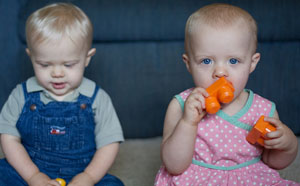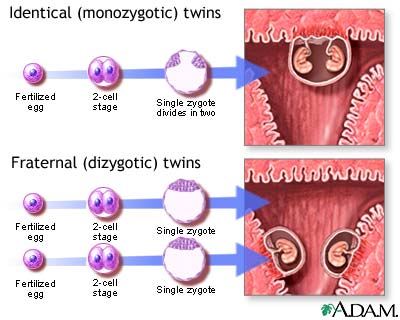Twins are a wonder of nature. There are basically two types of twins, defined by their genetic relationship: identical twins (monozygotic twins) and fraternal twins (dizygotic twins).
Contents:
Identical (Monozygotic) Twins
Fraternal (Dizygotic) Twins
Monozygotic vs. Dizygotic Twins
Identical (Monozygotic) Twins
Identical twins came from a single egg that split into two. They’re genetically identical and (obviously) always the same gender. Early first trimester ultrasound scan can identify approximately two-thirds of monozygotic twins. Our own twins were mis-diagnosed at a second-trimester ultrasound as identical (they weren’t). This type of twins is rare, comprising less than 1% of pregnancies in the United States. The chance of having identical twins is double for couples undergoing assistive reproductive procedures, though it’s not clear why.
Because they share a genetic profile and usually grow up together, identical twins are often sought for twin studies in the psychiatric and biomedical fields. Obviously, though genetically identical, they are unique individuals with different personalities and occasionally differences in appearance or disease susceptibility.
Monochorionic and Dichorionic Twins
About 75% of identical (monozygotic) twins are monochorionic, meaning that they share the same placenta. Such twins are watched carefully during pregnancy, as their rate of mortality is four times that of a singleton baby. The remaining 25% of twins are dichorionic (each in a distinct placenta), which has a mortality rate of two times that of a singleton.
Monoamniotic/Diamniotic Twins
Most twins are monochorionic-diamniotic (abbreviated MoDi), meaning that they share a placenta but each have their own amniotic sac within the mother’s uterus. About one-fifth of MoDi twin pairs experience something called twin-to-twin transfusion syndrome (TTTFS), in which blood moves from one twin to the other while in the womb. This is a concern, because one baby usually has too little blood, and one has too much. At birth, the donor twin is usually smaller, with paleness, dehydration, and anemia; the recipient twin is larger with redness and elevated blood pressure. As long as the twin-to-twin transfusion is mild, both babies are expected to fully recover.
Monochorionic-monoamniotic twins (same placenta, same amniotic sac) are very rare (2% of twins) and have the greatest risk of mortality or birth defects.
Fraternal (Dizygotic) Twins
Fraternal twins came from different eggs and are siblings, but not genetically identical. This is the more common type of twin, representing about two-thirds of twin pregnancies. When conceived naturally, fraternal twins indicate that two eggs were released by the mother’s ovaries instead of one. The chance of having fraternal twins increases with age (when a woman’s cycle can become less regular), and certainly with certain types of assistive reproductive technologies. With IVF, for example, multiple embryos are usually inserted to increase the likelihood of success.
Like any other siblings, fraternal twins share about 50% of their DNA. They are also of interest for biomedical studies because they’re age-matched and usually grow up in the same environment.
Monozygotic vs. Dizygotic Twins
Sometimes, particularly in the medical and research communities, you might hear of twins referred to as monozygotic or dizygotic. These terms refer to whether or not the twins came from the same zygote (fertilized egg). Here is a diagram that illustrates the difference:
Monozyotic twins come from a single fertilized egg; dizygotic twins come from two.
Research on Twins
There is a significant amount of research conducted using pairs of twins, particularly genetic studies. Identical twins are of particular interest because they share the same DNA. However, there can be rare, subtle differences — occasionally a mutation may occur in one twin and not the other — and sometimes these may cause disease. Such discordant twins, as they’re called, are important because they have relatively few genetic differences so the cause might be easier to find.
Fraternal twins are also of interest to researchers because they’re not genetically matched (though they share 50% of their DNA), but they are the same age and usually share the same environment.
What To Read Next
If you like this article, you might want to subscribe by e-mail or RSS so that you’re notified when new content is posted.
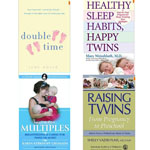 |
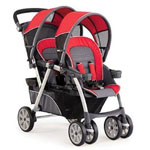 |
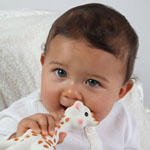 |
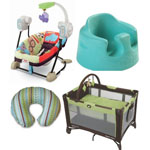 |
| Read about our recommended 7 books for new parents of twins. | We own seven strollers. Read about our favorites in our double stroller reviews. | When your babies are teething, here are a few ways to offer some relief. | Twins taking over the house? See our 6 ways to contain and entertain twins. |

